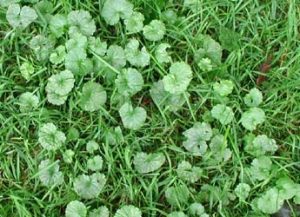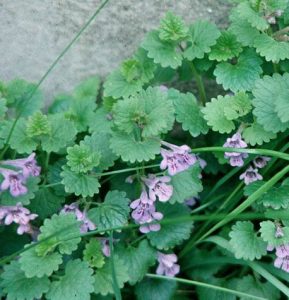Ground Ivy
By Lynne Pieri-Finn, Fairfax Master Gardener Intern
 Ground ivy (Glechoma hederacea) is a perennial, evergreen broadleaf weed. It is a native of Europe and Asia and was first introduced into the US in 1829 and is primarily found in the northeastern, north-central and southern United States. Some call Ground ivy “Creeping Charlie” or “Gill-over-the-ground.”
Ground ivy (Glechoma hederacea) is a perennial, evergreen broadleaf weed. It is a native of Europe and Asia and was first introduced into the US in 1829 and is primarily found in the northeastern, north-central and southern United States. Some call Ground ivy “Creeping Charlie” or “Gill-over-the-ground.”
Ground ivy blooms from March to July. It is an aggressive creeper along the soil surface. It is a member of the mint family and smells like rancid mint when crushed. You will find it in both sun and shade, but it prefers moist, shady places. It is primarily a weed of turfgrass and flower beds, but you will also see it growing in your vegetable garden.

ground ivy with flower
To identify ground ivy, look for oppositely-arranged scalloped leaves that are heart-shaped and have distinct veins. The creeping stems are distinctly square-shaped. Two-lipped violet trumpet flowers bloom in whorls of leaf axils. Flowers have five petals and four stamens and one pistil if male; females are smaller and have no stamen. Seedlings rarely occur and when they do, each flower produces only four seeds. Not bad, compared to other weeds.
Use mechanical means to remove Ground ivy where possible. You may want to consider replacing the Ground ivy in flower beds or vegetable gardens with shade-tolerant ground cover plants or mulch. Improving surface drainage and aerating will help reduce Ground ivy.

closeup of leaf
Ground ivy looks like Henbit (Lamium amplexicaule), Deadnettle (Lamium purpureum), and Common mallow (Malva neglecta). The key is to look for the shape of the stems (square), shape of the flower (trumpet-like), the arrangement of the leaves (opposite), rooting at the stem nodes, a horizontal growth pattern and the smell when crushed.
References
Ground Ivy (Glechoma hederacea), Virginia Cooperative Extension
Controlling Ground Ivy in Home Lawns, FS1219, November 2013, New Jersey Agricultural Experiment Station
Ground Ivy, North Carolina State Extension
Weeds of North America, Richard Dickinson and France Royer, University of Chicago Press, 2014
Lawn: Weeds, Virginia Pest Management Guide, 2018